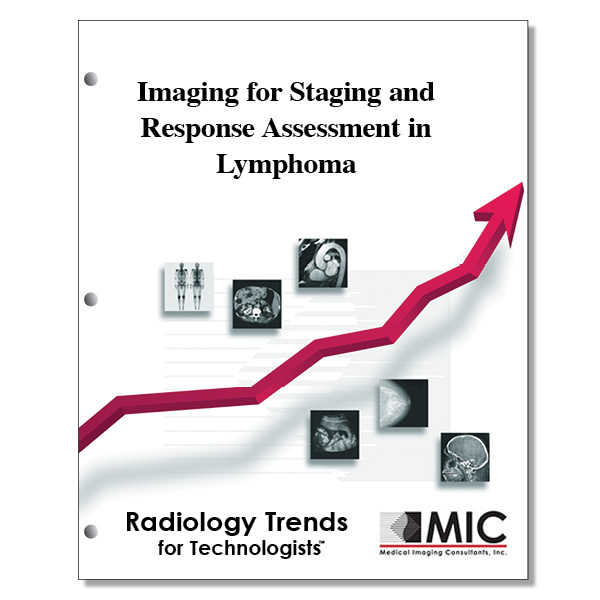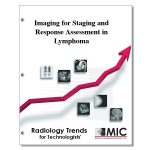

Imaging for Staging and Response Assessment in Lymphoma
A presentation of the recent system for staging and response assessment of lymphoma along with a spectrum of imaging findings.
Course ID: Q00461 Category: Radiology Trends for Technologists Modalities: CT, MRI, Nuclear Medicine, PET, Radiation Therapy2.5 |
Satisfaction Guarantee |
$29.00
- Targeted CE
- Outline
- Objectives
Targeted CE per ARRT’s Discipline, Category, and Subcategory classification:
[Note: Discipline-specific Targeted CE credits may be less than the total Category A credits approved for this course.]
Computed Tomography: 1.50
Procedures: 1.50
Head, Spine, and Musculoskeletal: 0.50
Neck and Chest: 0.50
Abdomen and Pelvis: 0.50
Magnetic Resonance Imaging: 1.75
Patient Care: 0.25
Patient Interactions and Management: 0.25
Procedures: 1.50
Body: 1.00
Musculoskeletal: 0.50
Nuclear Medicine Technology: 1.50
Procedures: 1.50
Endocrine and Oncology Procedures: 1.50
Registered Radiologist Assistant: 1.50
Procedures: 1.50
Neurological, Vascular, and Lymphatic Sections: 1.50
Outline
- Introduction
- Lymphoma Staging
- US, CT, and MR Imaging in Lymphoma
- The Evolving Role of PET Imaging in Lymphoma
- Lymphoma Treatment
- Hodgkin Lymphoma
- Non-Hodgkin Lymphoma
- Response Assessment
- Staging and Response Assessment: Historical Development
- The Lugano Classification
- Additional Recommendations in the Lugano Classification
- Quantification of Treatment Response with FDG PET/CT
- Discussion of New Response Criteria
- Interim Imaging
- Imaging after Completion of Treatment
- Conclusion
Objectives
Upon completion of this course, students will:
- identify known risk factors for lymphoma
- identify viruses that have been linked to lymphoma development
- understand the stages of the Ann Arbor staging system
- identify the staging system used to stage primary cutaneous lymphoma
- list the body components assessed by the TNMB staging system
- describe the lymphoma subtype that accounts for 10% of all lymphomas
- describe the lymphoma subtype that accounts for 33% of non-Hodgkin lymphomas
- list the lymphoma subtype that typically demonstrates high FDG uptake on PET/CT scans
- describe the characteristics of pulmonary lymphoma
- list the lymphoma subtypes that commonly demonstrate splenic involvement
- describe the observations that strongly suggest splenic involvement with lymphoma
- identify the abdominal organs that are rarely associated with primary lymphoma
- identify the gastrointestinal structures that are rarely involved with lymphoma
- indicate the region of the small bowel where lymphoma commonly occurs
- describe the characteristics of primary lymphoma of bone
- list the imaging findings that are classified as nonmeasurable disease
- describe common sites of extranodal involvement of non-Hodgkin lymphoma
- identify the primary imaging modality for CNS evaluation in lymphoma
- describe the percentage of non-Hodgkin lymphoma cases represented by CNS lymphoma
- compare the imaging findings of CNS lymphoma and other CNS disease processes
- define the role of FDG PET/CT in the evaluation of lymphoma
- describe the percentage reduction in maximum SUV on FDG PET/CT that indicates satisfactory therapeutic response
- compare the sensitivity and specificity of FDG PET/CT with those of contrast-enhanced CT in identifying lymph node and organ involvement
- identify the medication in the R-CHOP chemotherapy regimen that can cause a flare response and lead to a false-positive FDG PET/CT scan
- list the chemotherapy agents that are part of the ABVD regimen
- list the chemotherapy agents that are part of the BEACOPP regimen
- identify the common type of aggressive non-Hodgkin lymphoma that R-CHOP is used to cure
- list the chemotherapy agents that are administered consecutively with R-CHOP for the treatment of bulky disease
- describe the timeline of the Cotswolds modifications to the Ann Arbor staging system
- list the response assessment systems that define clinical response based on FDG avidity of lesions on PET/CT
- describe the CT image findings that correspond to the different response assessment categories
- describe the PET/CT image findings that correspond to the different response assessment categories
- define the size criteria of bulky disease in Hodgkin lymphoma
- identify the evaluation process that provides the earliest evidence of recurrent disease
- describe the usefulness of surveillance FDG PET/CT scans after the completion of treatment
